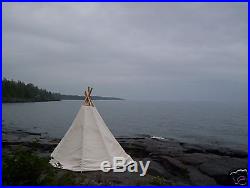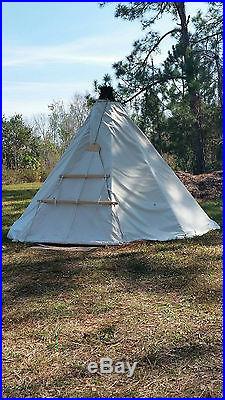Posted on July 3rd, 2017
admin








Note: the poles shown in the photo are not included with the order, but can be made with the instruction booklet that comes with the order. What is a Lavvu? The Lavvu is a temporary dwelling used by the Sami people (also spelled “Saami”, but derogatorily known as’Lapps’ or’Laplanders’) of northern Scandinavia and the Nenets and Khants of northern Russia. Its simplicity enabled the Sami to move quickly with their semi-domesticated reindeer herds at a moment’s notice. This structure enabled the indigenous cultures of the treeless plains of northern Scandinavia and the High Arctic of Eurasia to live in harmony with nature. Although the Lavvu can be easily confused with the Native American Tipi. It’s not a Tipi! The differences between the two structures are reflected in their respective environments and cultures. The lavvu is normally smaller and can be set up by only one person. Being more centered to the ground, the Lavvu is also better able to endure the fierce winds of the Scandinavian tundra, thus a more stable structure. Few structures used by indigenous peoples, with the exception of the Inuit (Eskimo) Igloo, are as stable in strong winds. What are the materials in this lavvu? This lavvu is made of 12 ounce Cotton Duck fabric, which is a common and natural material used for tents and shelters. Many tipis in North America are made of this material and it will last for many years with proper care. Cotton duck is moderately water resistant and is a good fire resistance material. However, Cotton Duck has poor resistance against mold and mildew, and should be air or machine dried before packing away. Cotton duck is not recommended is you plan to keep your lavvu out over the season. If you plan to do this, please look at our other material for lavvus, Sunforger. In the official terminology, Sunforger is called a marine grade, boat shrunk, mildew resistant, flame retardant, and water repellent. Our Sunforger fabric meets CPAI-84 requirements for flame retardantcy of the State of California (which US material manufacturers use as the industry standard). Cotton Duck is a natural alternative camping material for the pure naturalist, and has been used for centuries by many different cultures. What does the lavvu look like? This lavvu is twelve feet/3.6 meter in diameter, about ten feet/3 meter high and can sleep four people very comfortably with a fire inside, or five people without the fire. There is a smoke hole at the top to let smoke rise out of the lavvu and during set-up, can be made small enough to keep rain or snow out. There is an attached door, a carrying bag, and a thirty-plus page booklet that describes everything you need to know about the lavvu. Similar to a Native American Teepee, there are no guy-wires or ropes to worry about as with other tents. Lavvu, meaning that there are other tents out there that claim to have a’lavvu’, but are something very different. Our traditional lavvus are not made of synthetic materials – you can have a fire inside without the worry of polyester melting or fire hazards. There is no center pole in a real lavvu , which means the interior has more open space so that you can have a campfire inside to cook or keep warm – in winter or summer. The lavvu can be set up quickly by one person in less than ten minutes and taken down in half that, with the total weight for this 12 foot/3.6 meter lavvu at about 35 pounds. Unlike the tipi, a Lavvu dose not need any stakes! No stakes are need for the lavvu. Because of the lower angle of the tent wall, the wind tends to push the lavvu into the ground, rather than pushing it over. The tipi requires stakes to be pounded into the ground, as the wind will tend to blow it over. IMPORTANT – The door color for this lavvu will come in the standard natural off-white – the same color as the fabric color in th e photos. Are poles needed for the lavvu? The booklet that comes with the order will tell you how to make your own poles. Thank you for stopping by.. The item “Sami Lavvu 12ft/3.6m Cotton Duck Sami Traditional Tent (tipi/tepee/yurt/ger)” is in sale since Saturday, April 13, 2013. This item is in the category “Sporting Goods\Outdoor Sports\Camping & Hiking\Tents & Canopies\Tents”. The seller is “honest_zen” and is located in Saint Paul, Minnesota. This item can be shipped worldwide.
- Capacity: 4-5 Persons
- Country/Region of Manufacture: United States
- Size: 12 foot / 3.6 meter











Recent Comments